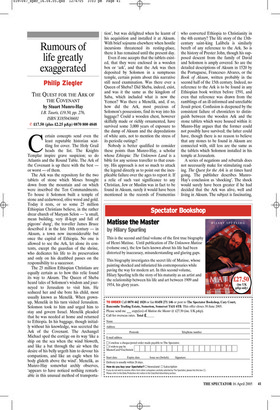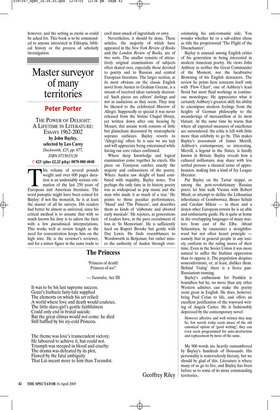Rumours of life greatly exaggerated
Philip Ziegler
THE QUEST FOR THE ARK OF THE COVENANT by Stuart Munro-Hay I.B. Tauris, £19.50, pp. 276, ISBN X1850436681 ✆ £17.50 (plus £2.25 p&p) 0870 800 4848 Certain concepts send even the least reputable historian scuttling for cover. The Holy Grail heads the list. The Knights Templar inspire grave suspicion; so do Atlantis and the Round Table. The Ark of the Covenant is up there with the best or worst — of them.
The Ark was the repository for the two tablets of stone which Moses brought down from the mountain and on which were inscribed the Ten Commandments. To house it Solomon built a temple of stone and cedarwood, olive wood and gold. Today it rests, or so some 25 million Ethiopian Christians believe, in the rather drear church of Maryam Selon — ‘a small, mean building, very ill-kept and full of pigeons’ dung’, the traveller James Bruce described it in the late 18th century — in Aksum, a town now inconsiderable but once the capital of Ethiopia. No one is allowed to see the Ark, let alone its contents, except the guardian of the shrine, who dedicates his life to its preservation and only on his deathbed passes on the responsibility to a successor.
The 25 million Ethiopian Christians are equally certain as to how this relic found its way to Aksum. The Queen of Sheba heard tales of Solomon’s wisdom and journeyed to Jerusalem to visit him. He seduced her and she bore his child, most usually known as Menelik. When grownup, Menelik in his turn visited Jerusalem. Solomon took to him and urged him to stay and govern Israel. Menelik pleaded that he was needed at home and returned to Ethiopia. In his baggage, though initially without his knowledge, was secreted the Ark of the Covenant. The Archangel Michael sped the cortège on its way ‘like a ship on the sea when the wind bloweth, and like a bat through the air when the desire of his belly urgeth him to devour his companions, and like an eagle when his body glideth above the wind’. Menelik, as Munro-Hay somewhat archly observes, ‘appears to have noticed nothing remarkable in this unusual method of transporta tion’, but was delighted when he learnt of his acquisition and installed it at Aksum. With brief sojourns elsewhere when hostile incursions threatened its resting-place, there it has remained until the present day.
Even if one accepts that the tablets existed, that they were enclosed in a wooden box or ‘ark’, and that the Ark was then deposited by Solomon in a sumptuous temple, certain points about this narrative still need examination. Was there ever a Queen of Sheba? Did Sheba, indeed, exist, and was it the same as the kingdom of Saba, which included what is now the Yemen? Was there a Menelik, and, if so, how did the Ark, most precious of Solomon’s possessions, find its way into his luggage? Could a wooden chest, however skilfully made or richly ornamented, have survived some 3,000 years of exposure to the damp of Aksum and the depredations of white ants, not to mention the stress of its periodic outings?
Nobody is better qualified to consider these points than Munro-Hay, a scholar whose Ethiopia: The Unknown Land is a bible for any serious traveller to that country. His approach is not so much to attack the legend directly as to point out the inexplicable failure over the ages to report it. If a relic of such vast significance to any Christian, Jew or Muslim was in fact to be found in Aksum, surely it would have been mentioned in the records of Frumentius who converted Ethiopia to Christianity in the 4th century? The life story of the 13thcentury saint-king Lalibela is similarly bereft of any reference to the Ark. So is the history of Prester John, though his supposed descent from the family of David and Solomon is amply covered. So are the detailed descriptions of Aksum in 1520 by the Portuguese, Francesco Alvares, or the Book of Aksum, written probably in the second half of the 15th century. Indeed, no reference to the Ark is to be found in any Ethiopian book written before 1591, and even that reference was drawn from the ramblings of an ill-informed and unreliable Jesuit priest. Confusion is deepened by the consistent failure of chroniclers to distinguish between the wooden Ark and the stone tablets which were housed within it: Munro-Hay argues that the former could not possibly have survived; the latter could have, though there is no reason to believe that any stones to be found in Aksum are connected with, still less are the same as the tablets which Solomon installed in his temple at Jerusalem.
A series of negations and rebuttals does not necessarily make for stimulating reading. The Quest for the Ark is at times hard going. The publisher describes MunroHay’s conclusion as ‘shocking’. The shock would surely have been greater if he had decided that the Ark was alive, well and living in Aksum. The subject is fascinating, however, and the setting as exotic as could be asked for. This book is to be commended to anyone interested in Ethiopia, biblical history or the process of scholarly investigation.

























































 Previous page
Previous page